A Study on Flow Characteristics and Flow Uniformity for the Efficient Design of a Flow Frame in a Redox Flow Battery
Abstract
1. Introduction
2. Materials and Methods
2.1. Governing Equations
2.2. Computational Domain and Boundary Conditions
2.3. Porous Modeling of the Spacer
2.4. Design Parameters for Flow Uniformity
2.5. Experimental Setup
3. Results and Discussion
3.1. Numerical Software Validation
3.1.1. Comparison of Pressure Drop with Experimental Results
3.1.2. Comparison of Flow Pattern through Flow Visualization
3.2. Flow Characteristics of a Conventional RFB Frame Cell
3.3. New RFB Flow Frame Configuration
3.4. Flow Characteristics of the New RFB
4. Conclusions
Author Contributions
Funding
Conflicts of Interest
References
- Joerissen, L.; Garche, J.; Fabjan, C.; Tomazic, G. Possible use of vanadium redox-flow batteries for energy storage in small grids and stand-alone photovoltaic systems. J. Power Sources 2004, 127, 98–104. [Google Scholar] [CrossRef]
- Ponce de León, C.; Frías-Ferrer, A.; González-García, J.; Szánto, D.A.; Walsh, F.C. Redox flow cells for energy conversion. J. Power Sources 2006, 160, 716–732. [Google Scholar] [CrossRef]
- Nguyen, T.; Savinell, R.F. Flow batteries. Electrochem. Soc. Interface 2010, 19, 54. [Google Scholar] [CrossRef]
- Reddy, T. Linden’s Handbook of Batteries; McGraw-Hill Education: New York, NY, USA, 2010. [Google Scholar]
- Ke, X.; Prahl, J.M.; Alexander, J.I.D.; Wainright, J.S.; Zawodzinski, T.A.; Savinell, R.F. Rechargeable redox flow batteries: Flow fields, stacks and design considerations. Chem. Soc. Rev. 2018, 47, 8721–8743. [Google Scholar] [CrossRef] [PubMed]
- Xu, Q.; Zhao, T.S.; Leung, P.K. Numerical investigations of flow field designs for vanadium redox flow batteries. Appl. Energy 2013, 105, 47–56. [Google Scholar] [CrossRef]
- Bengoa, C.; Montillet, A.; Legentilhomme, P.; Legrand, J. Flow visualization and modelling of a filter-press type electrochemical reactor. J. Appl. Electrochem. 1997, 27, 1313–1322. [Google Scholar] [CrossRef]
- Escudero-González, J.; López-Jiménez, P.A. Redox cell hydrodynamic modelling: Towards real improved geometry based on CFD analysis. Eng. Appl. Comput. Fluid Mech 2014, 8, 435–446. [Google Scholar] [CrossRef][Green Version]
- Escudero-González, J.; López-Jiménez, P.A. Methodology to optimize fluid-dynamic design in a redox cell. J. Power Sources 2014, 251, 243–253. [Google Scholar] [CrossRef]
- Ma, X.; Zhang, H.; Sun, C.; Zou, Y.; Zhang, T. An optimal strategy of electrolyte flow rate for vanadium redox flow battery. J. Power Sources 2012, 203, 153–158. [Google Scholar] [CrossRef]
- Reed, D.; Thomsen, E.; Li, B.; Wang, W.; Nie, Z.; Koeppel, B.; Sprenkle, V. Performance of a low cost interdigitated flow design on a 1 kW class all vanadium mixed acid redox flow battery. J. Power Sources 2016, 306, 24–31. [Google Scholar] [CrossRef]
- Messaggi, M.; Canzi, P.; Mereu, R.; Baricci, A.; Inzoli, F.; Casalegno, A.; Zago, M. Analysis of flow field design on vanadium redox flow battery performance: Development of 3D computational fluid dynamic model and experimental validation. Appl. Energy 2018, 228, 1057–1070. [Google Scholar] [CrossRef]
- Bortolin, S.; Toninelli, P.; Maggiolo, D.; Guarnieri, M.; Del Col, D. CFD study on electrolyte distribution in redox flow batteries. J. Phys. Conf. Ser. 2015, 655, 012049. [Google Scholar] [CrossRef]
- Kim, M.; Yun, D.; Jeon, J. Effect of a bromine complex agent on electrochemical performances of zinc electrodeposition and electrodissolution in Zinc–Bromide flow battery. J. Power Sources 2019, 438, 227020. [Google Scholar] [CrossRef]
- Porous Media Condition. Available online: http://www.afs.enea.it/project/neptunius/docs/fluent/html/ug/node233.htm (accessed on 29 January 2019).
- Hirt, C.W.; Nichols, B.D. Volume of fluid (VOF) method for the dynamics of free boundaries. J. Comput. Phys. 1981, 39, 201–225. [Google Scholar] [CrossRef]
- Nathan, C. Title of Patent. U.S. Patent No.US20140162095A1; Internal Header Flow Divider for Uniform Electrolyte Distribution, 12 June 2014. [Google Scholar]
- Poling, B.E.; Thomson, G.H.; Friend, D.G.; Rowley, R.L.; Wilding, W.V. Section 2: Physical and Chemical Data. In Perry’s Chemical Engineers’ Handbook; McGraw-Hill: New York, NY, USA, 2007; ISBN 0071542094. [Google Scholar]
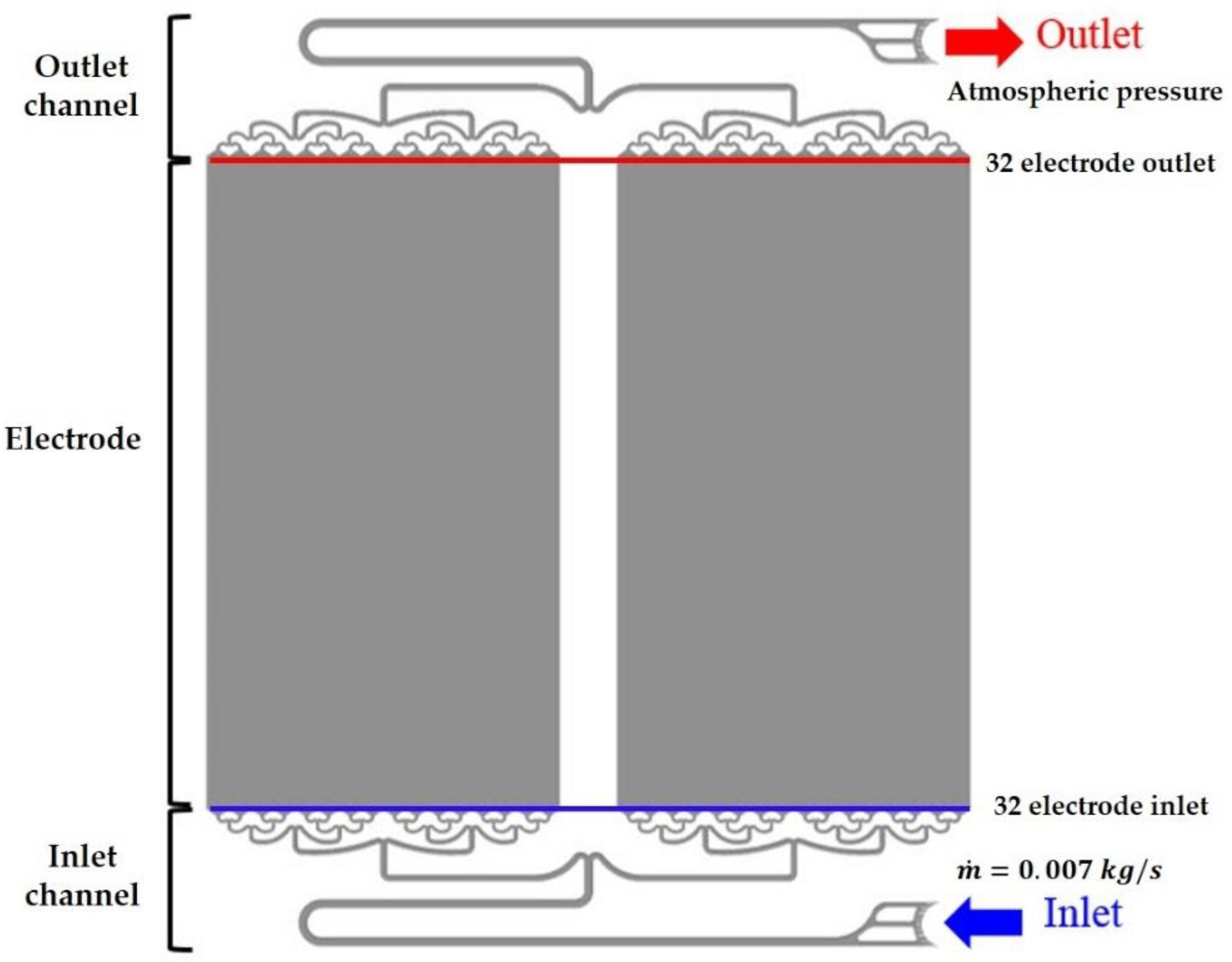
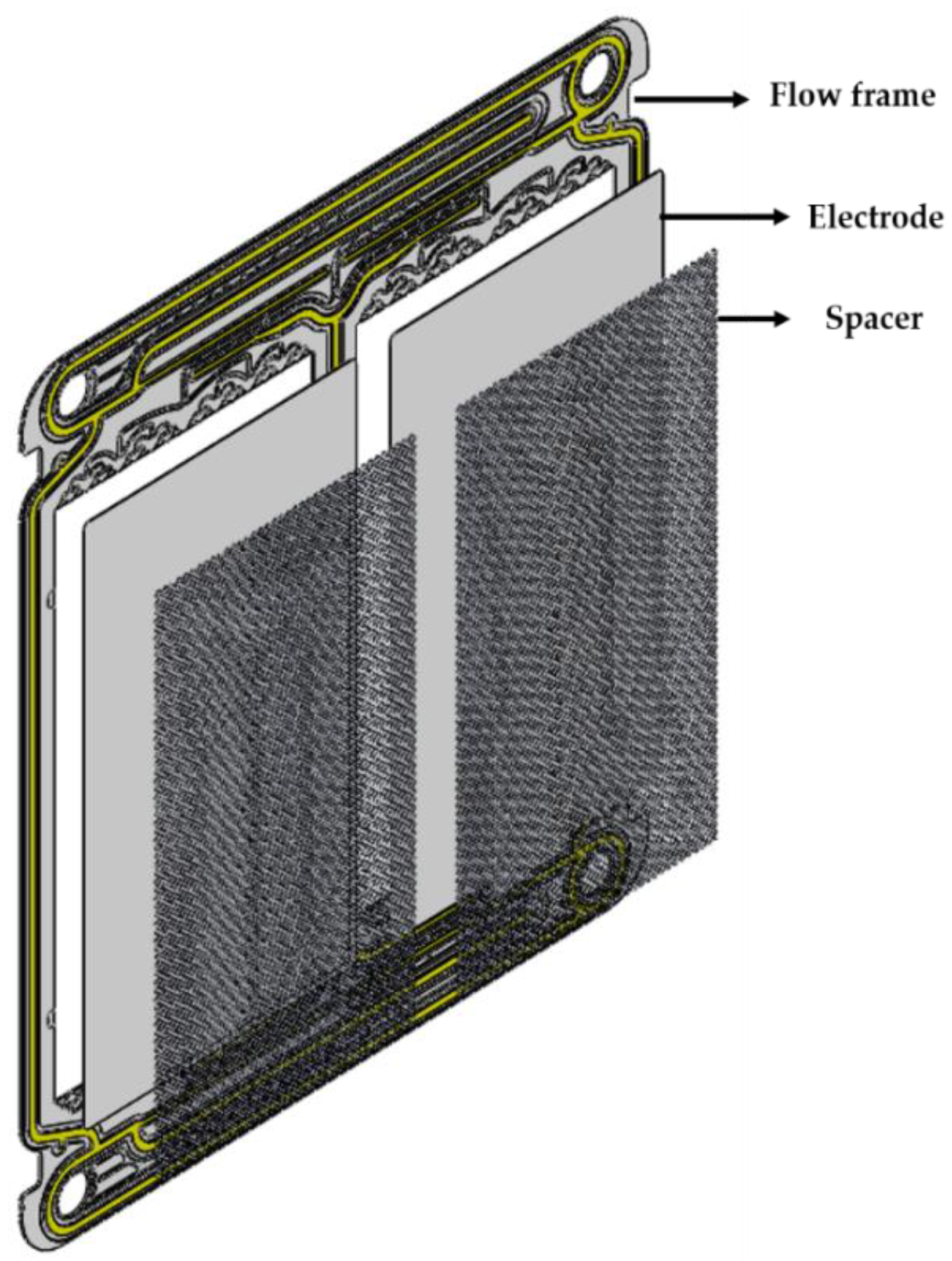
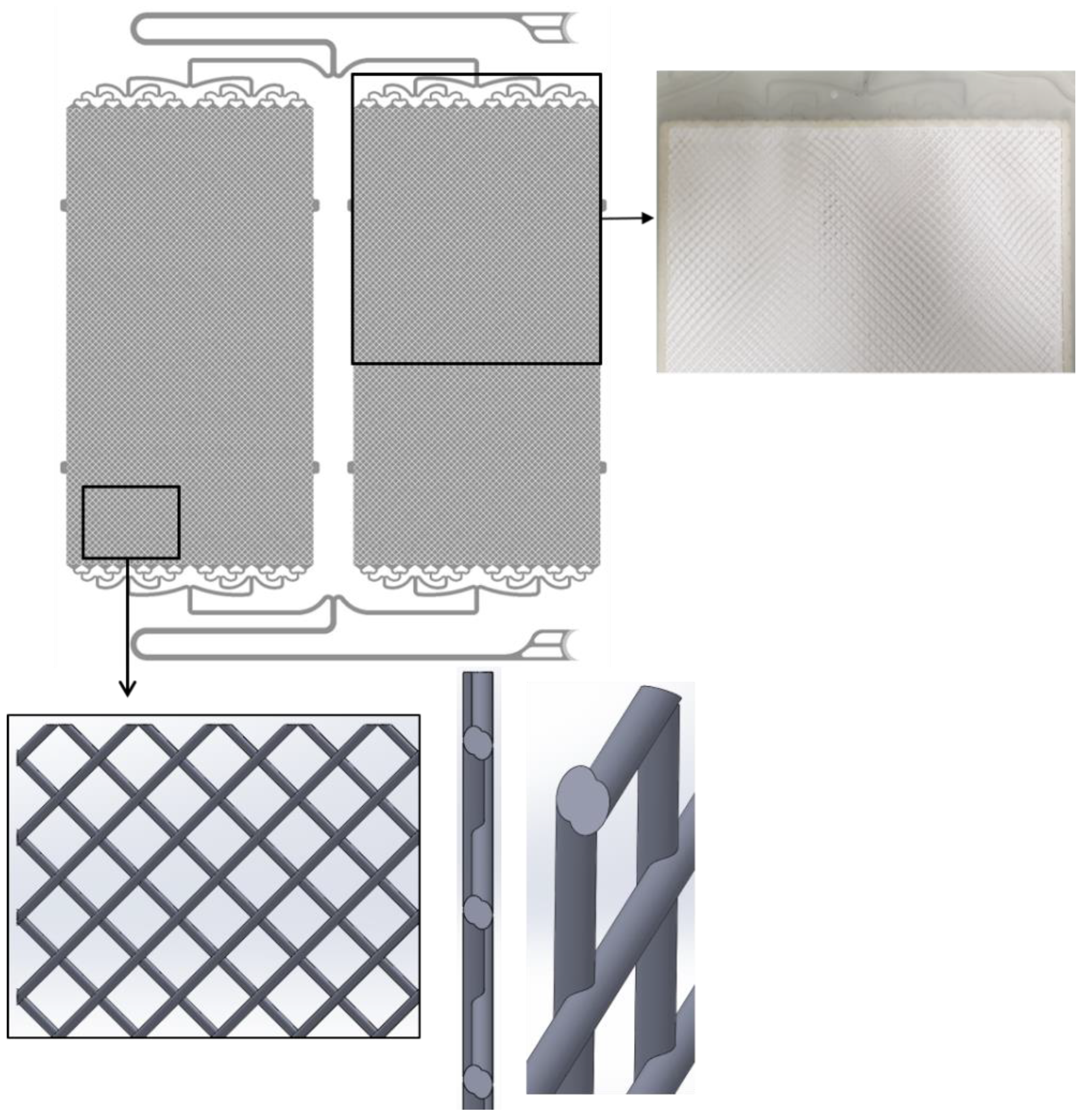
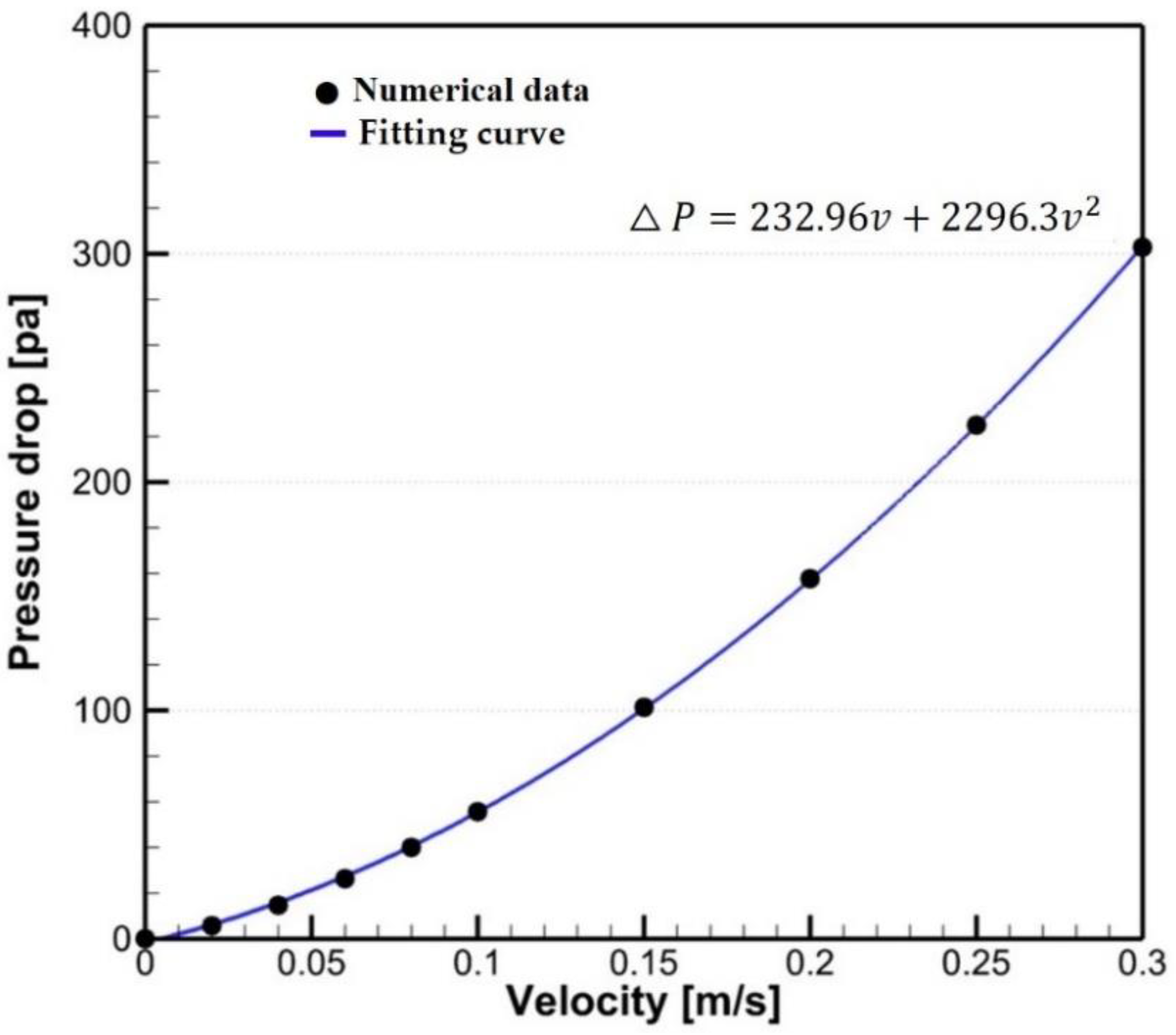



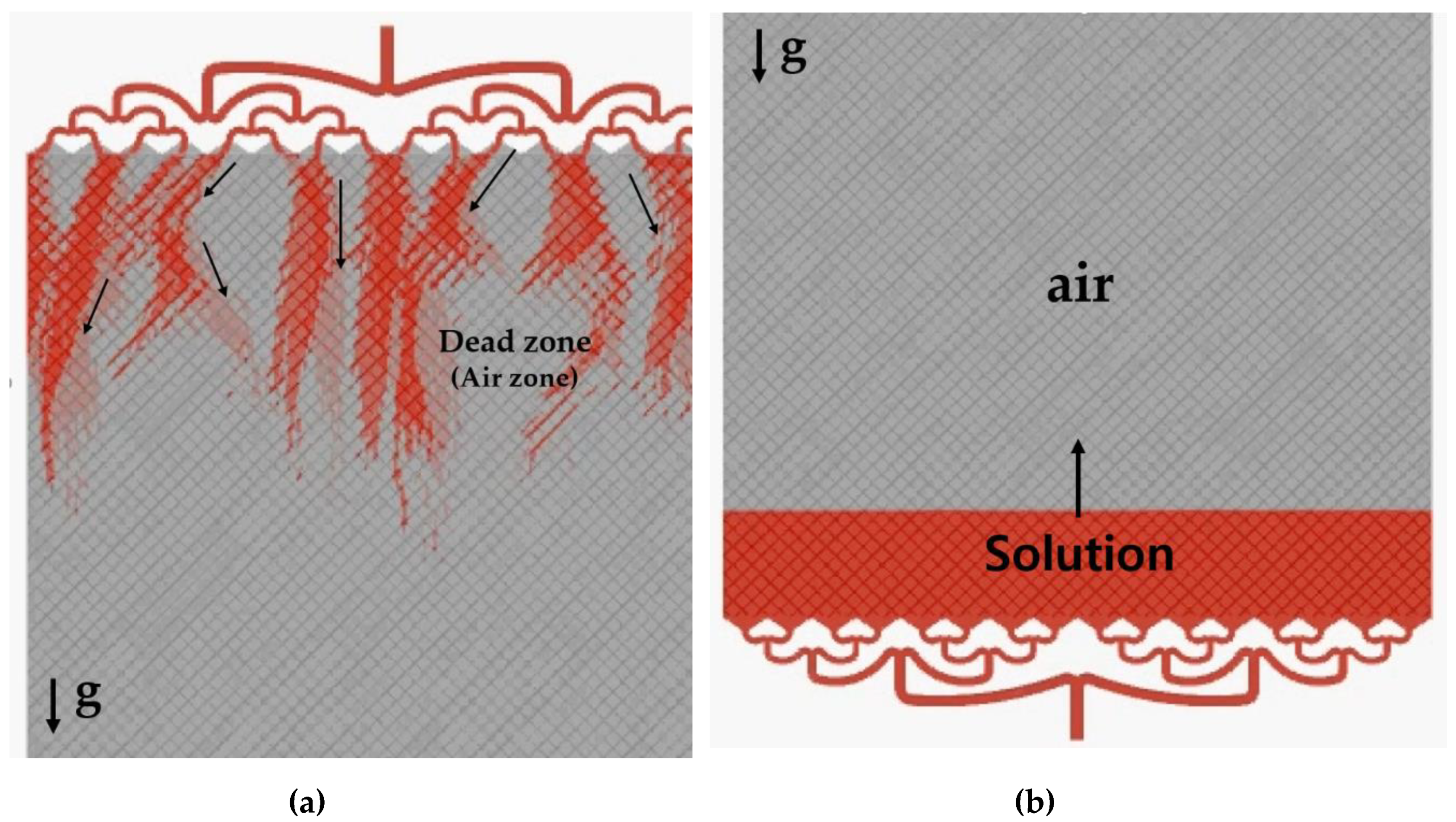
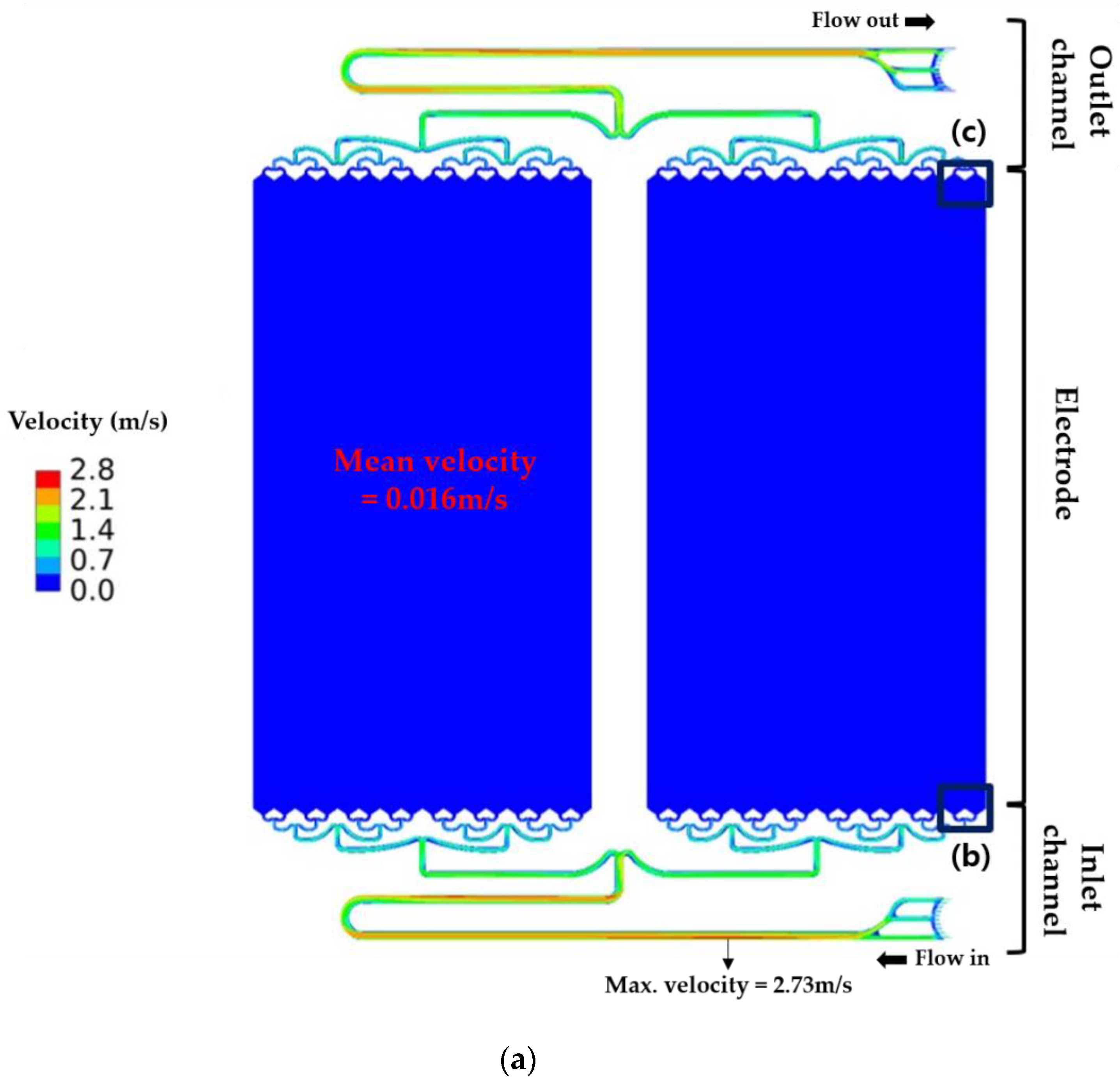
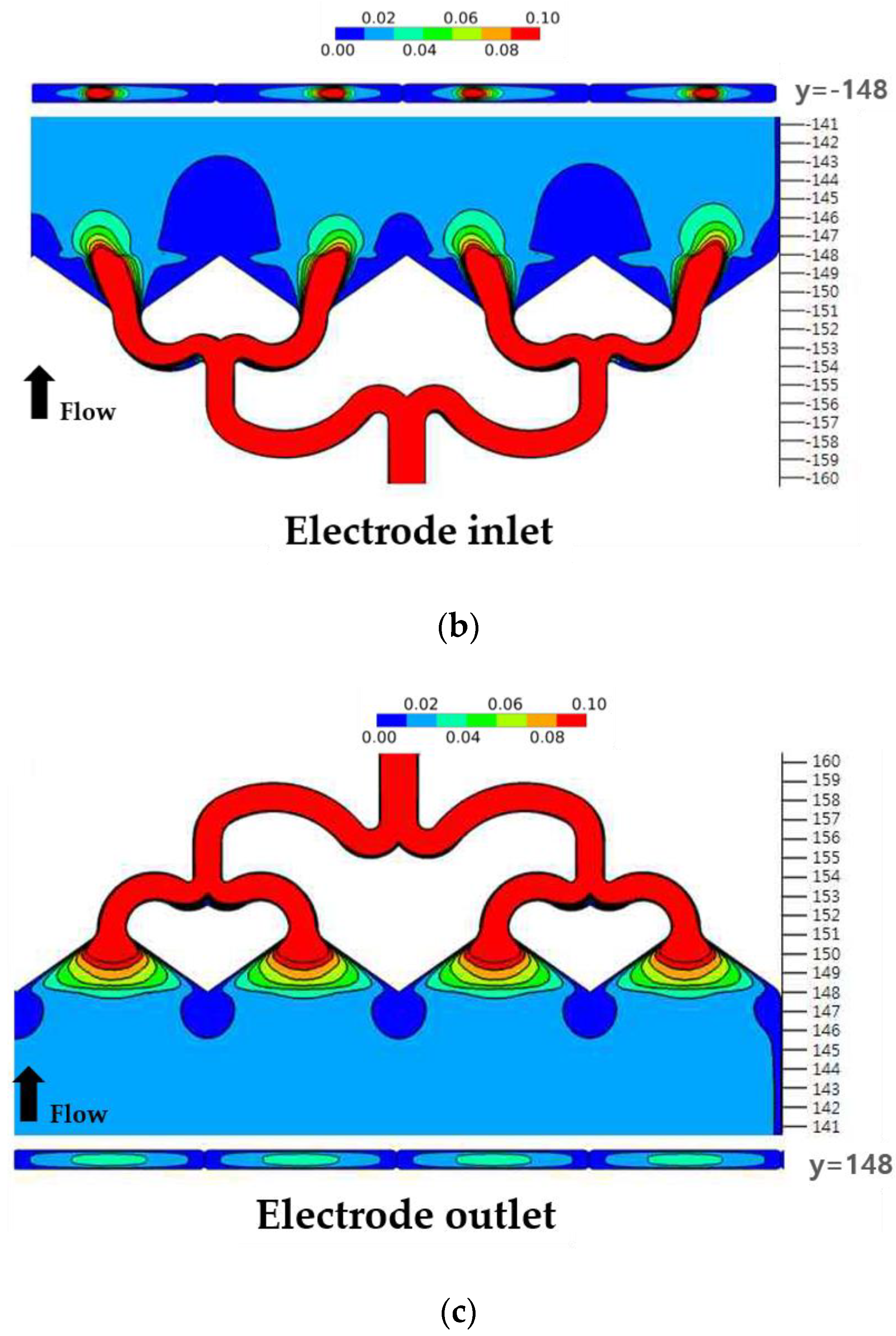

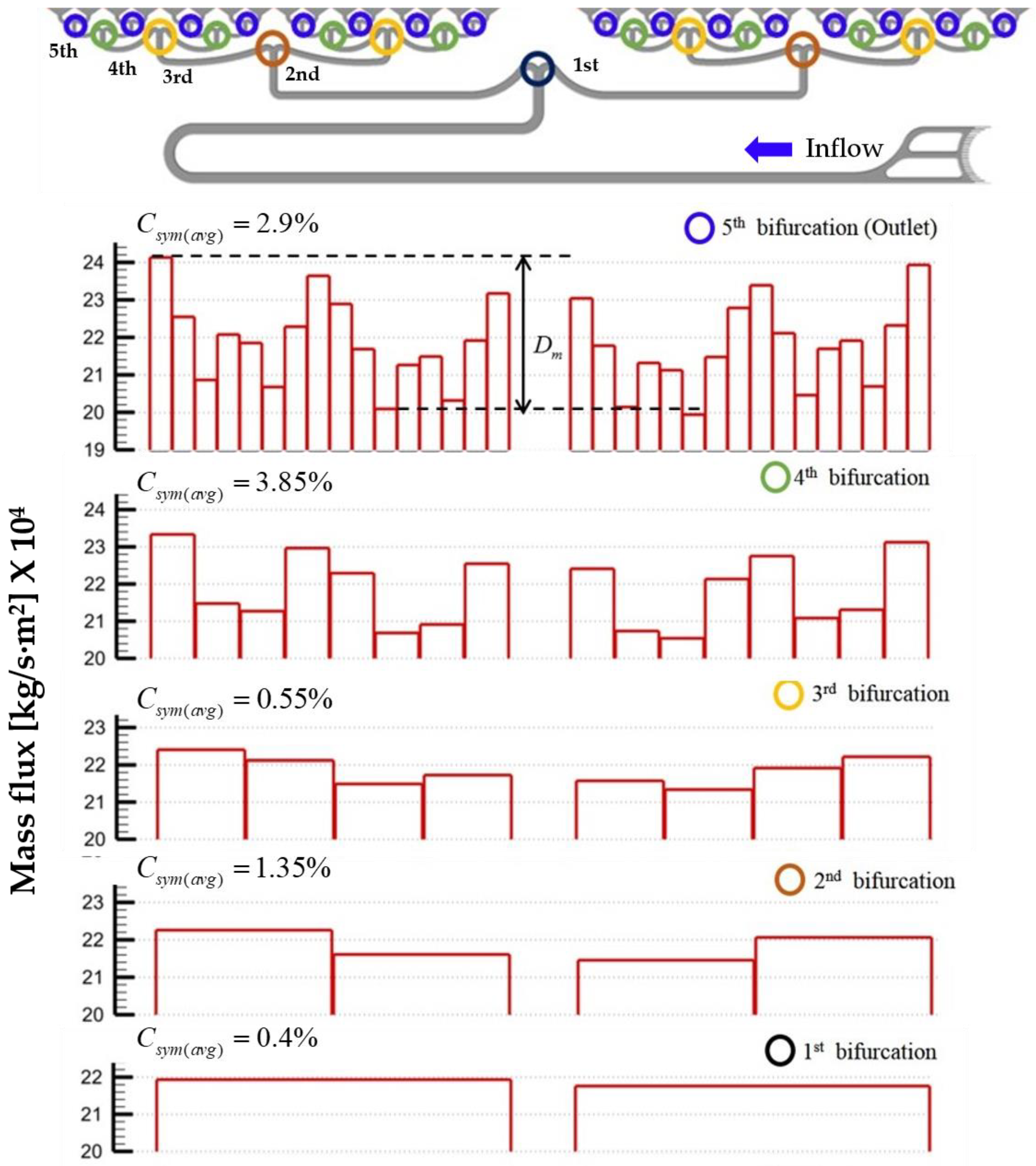
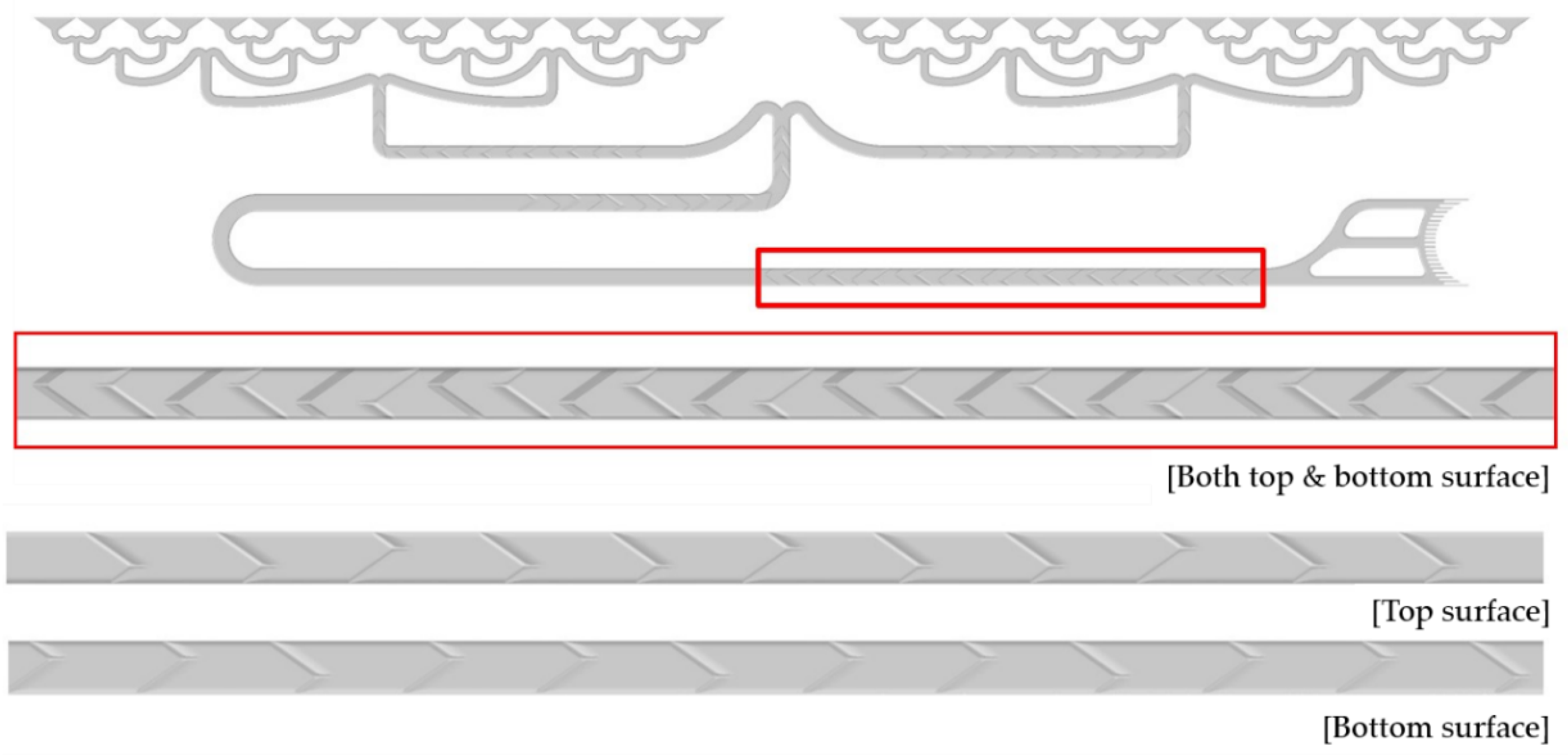


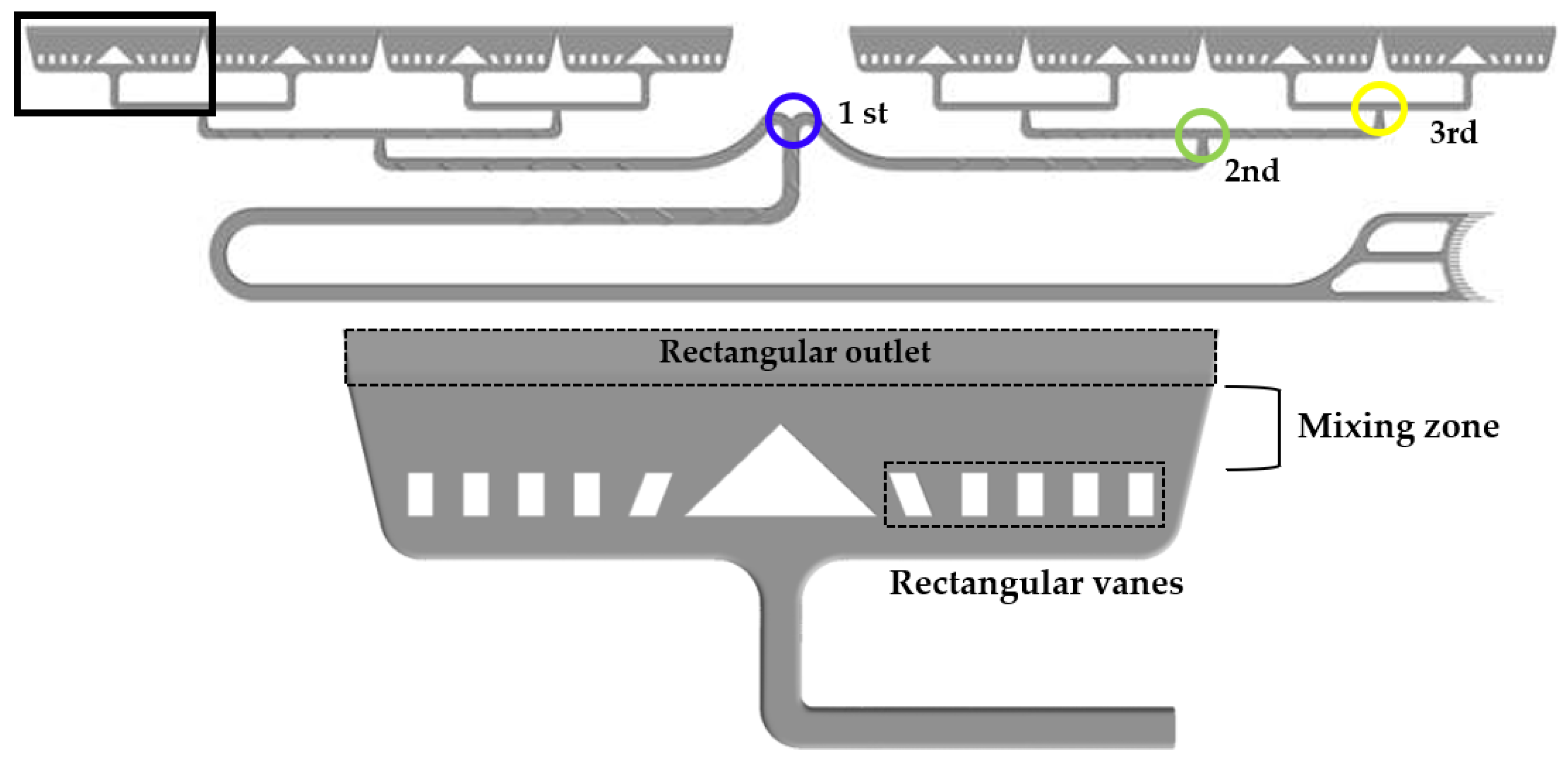
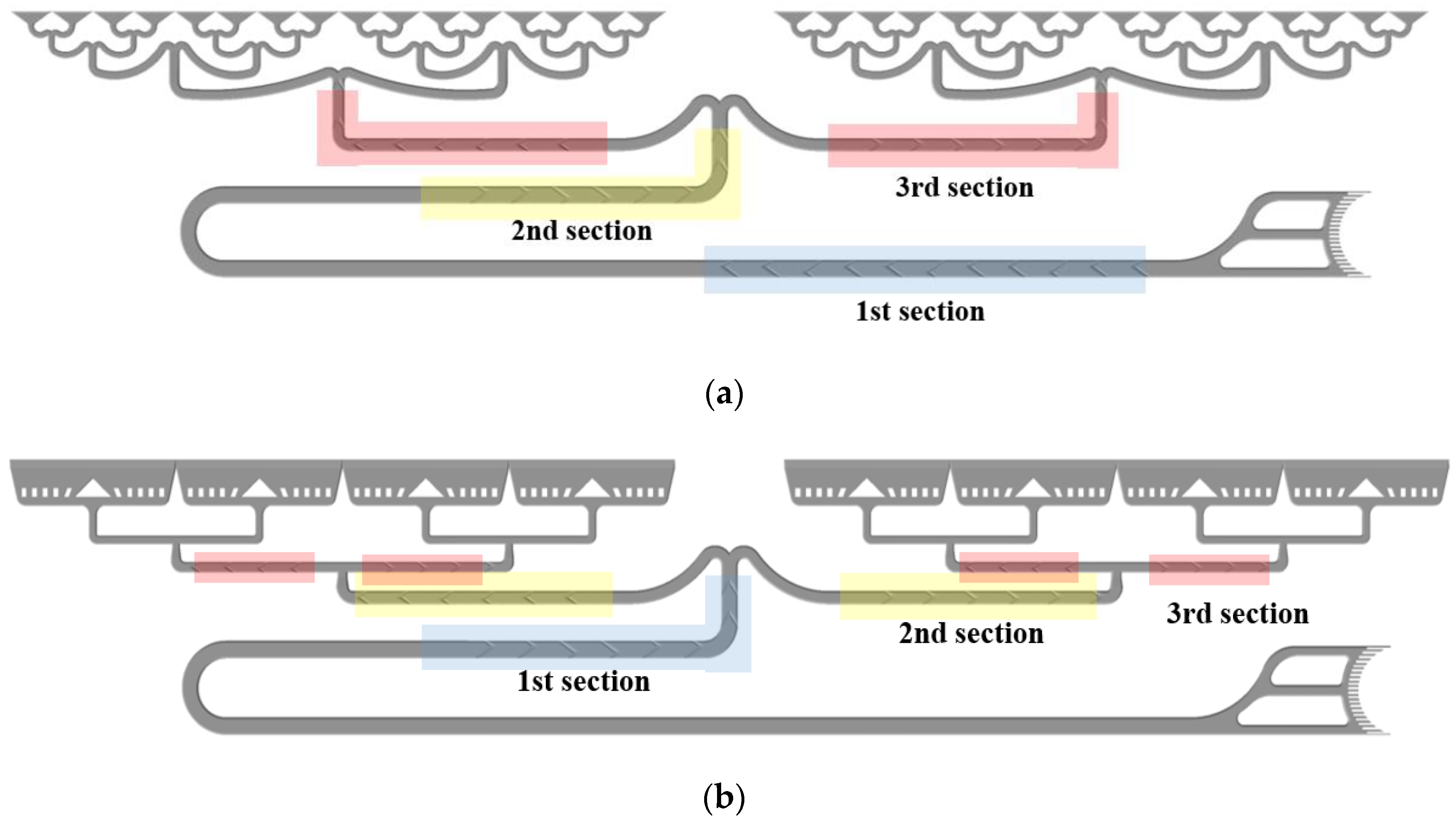
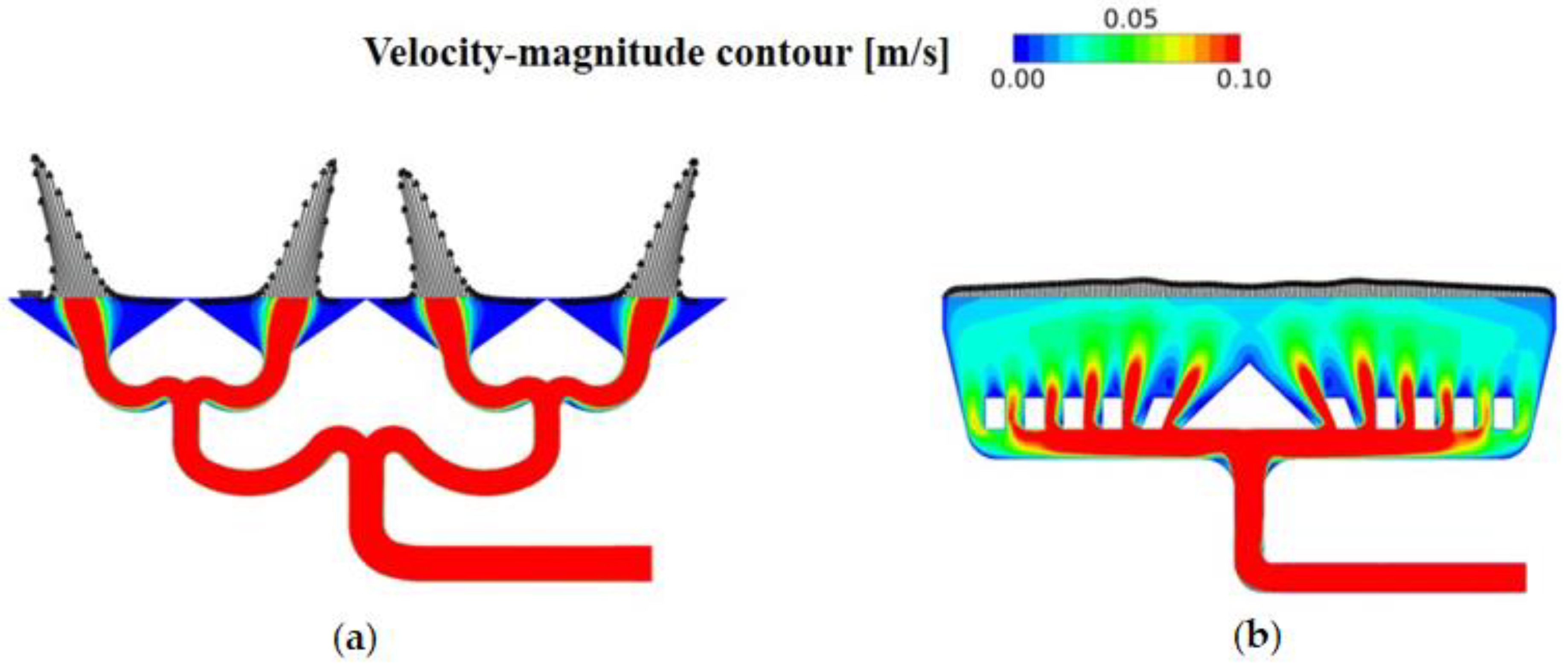


| Inlet | 0.3 LPM (0.007 kg/s) |
| Outlet | atmospheric pressure |
| 232.96 | |
| 2296.3 | |
| Viscous Resistance | 1/α = 2.6462E + 07 [1/m2] |
| Inertial Resistance | C2 = 727.7712 [1/m] |
| Instrument/Sensor | Model | Accuracy |
|---|---|---|
| Pressure transducer | Setra, model 206 | ±0.13% |
| Liquid pump | KNF, NF 1300 | ±1% |
| Data acquisition | Agilent, 34972A | ±1.5% |
| Inflow Type. | Energy Efficiency [%] | Voltage Efficiency [%] | Coulomb Efficiency [%] |
|---|---|---|---|
| Bottom inflow | 71.4 | 79.1 | 90.2 |
| Horizontal inflow | 74.4 | 80.5 | 92.5 |
| Region | Conventional Design (bar) | New Design (bar) | Difference (%) |
|---|---|---|---|
| Inlet channel | 0.501 | 0.424 | 15.3 |
| Electrode | 0.005 | 0.005 | 0 |
| Outlet channel | 0.488 | 0.431 | 11.6 |
| Whole region | 0.992 | 0.860 | 13.3 |
© 2020 by the authors. Licensee MDPI, Basel, Switzerland. This article is an open access article distributed under the terms and conditions of the Creative Commons Attribution (CC BY) license (http://creativecommons.org/licenses/by/4.0/).
Share and Cite
Kim, B.-R.; Sohn, D.-Y.; Choi, Y.-H.; Lee, Y.-H. A Study on Flow Characteristics and Flow Uniformity for the Efficient Design of a Flow Frame in a Redox Flow Battery. Appl. Sci. 2020, 10, 929. https://doi.org/10.3390/app10030929
Kim B-R, Sohn D-Y, Choi Y-H, Lee Y-H. A Study on Flow Characteristics and Flow Uniformity for the Efficient Design of a Flow Frame in a Redox Flow Battery. Applied Sciences. 2020; 10(3):929. https://doi.org/10.3390/app10030929
Chicago/Turabian StyleKim, Bo-Ra, Deok-Young Sohn, Yun-Ho Choi, and Yong-Hee Lee. 2020. "A Study on Flow Characteristics and Flow Uniformity for the Efficient Design of a Flow Frame in a Redox Flow Battery" Applied Sciences 10, no. 3: 929. https://doi.org/10.3390/app10030929
APA StyleKim, B.-R., Sohn, D.-Y., Choi, Y.-H., & Lee, Y.-H. (2020). A Study on Flow Characteristics and Flow Uniformity for the Efficient Design of a Flow Frame in a Redox Flow Battery. Applied Sciences, 10(3), 929. https://doi.org/10.3390/app10030929





